January 11, 2013
Air Date: January 11, 2013
FULL SHOW
SEGMENTS
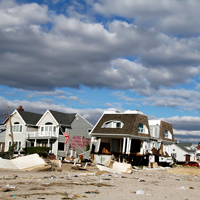
Insuring for Climate Change
View the page for this story
2012 Was the hottest year ever recorded in the United States as well as one of the most costly in terms of weather disasters like Hurricane Sandy. Ernst Rauch, head of the Corporate Climate Center for reinsurance company Munich Re tells host Steve Curwood that insurance companies are taking note of an increase in claims as a result of climate change. (07:20)

Big Buffett Solar Buy
View the page for this story
Warren Buffet has invested around $2.5 billion in two solar projects in Southern California. Buffet already owns several wind farms and this newest buy makes him one of the biggest solar photovoltaic investors in the United States. Host Steve Curwood talks with Ethan Zindler, head of policy analysis at Bloomberg New Energy Finance, about the implications of Buffett’s newest solar acquisition. (05:20)

Idle No More
View the page for this story
First Nations across Canada are protesting government measures they say undermine native sovereignty and degrade the environment. A chief is on hunger strike, and flash mobs are popping up across north America as part of the movement known as Idle No More. Native American environmental activist Winona LaDuke joins host Steve Curwood to discuss the movement. (07:50)

Introducing the Elf
/ Helen PalmerView the page for this story
ELF stands for Electric, Light and Fun. And as Living on Earth's Helen Palmer reports, the ELF is a new invention, a solar and human powered covered tricycle that might just help create a commuting revolution, and combat climate change as well. (11:30)
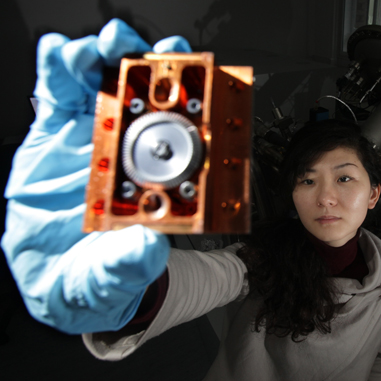
The Kilo is Gaining Weight
View the page for this story
If you’re worried about putting on a few kilos over the holiday season, you are not alone. Scientists at the University of Newcastle in the UK say that the standard kilogram itself is getting a little pudgy as well. The university's mechanical engineering Professor Peter Cumpson joins host Steve Curwood to discuss the weight that gained weight. (06:20)

A Bright Spot for Coral Reefs
View the page for this story
World wide, many coral reefs are dying as a result of increased sea temperatures and coral bleaching. But Stanford University professor of Marine Science, Steve Palumbi, tells host Steve Curwood that some populations of coral in the American Samoa are thriving in high ocean temperatures. These heat-adapted corals might provide hope that corals can adapt to a rapidly heating ocean. (07:00)
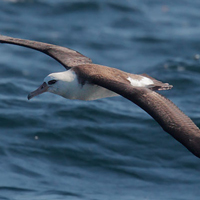
BirdNote®
/ Michael SteinView the page for this story
Though it's the middle of the northern winter, the large seabirds called Layson Albatrosses are busy raising chicks, as Michael Stein reports in BirdNote®. (02:05)
Show Credits and Funders
Show Transcript
HOST: Steve Curwood
GUESTS: Ernst Rauch, Ethan Zindler, Winona LaDuke, Peter Cumpson, Steve Palumbi,
REPORTERS: Helen Palmer, Michael Stein
[THEME]
CURWOOD: From Public Radio International - this is Living on Earth. I'm Steve Curwood. 2012 was the hottest year ever, beating the old record by a full degree, and it set new highs in terms of the dollar costs that wild weather and drought racked up.
RAUCH: Of the overall 160 billion dollars in economic losses world wide from natural disasters in 2012, 110 billion dollars were in terms of damage in US alone.
CURWOOD: Also, coming to a bike path near you sometime soon, the Elf — it’s a pedal and solar powered tricycle:
CHAMEIDES: Riding a bicycle's problematic, you're out in the open, you don't have protection from the sun and this wonderful invention, the Elf – you're actually enclosed just like a little tiny car and you've solar power assistance to get up the hill. What a great, great idea.
CURWOOD: We'll have these stories and more this week, on Living on Earth. Stick around!
[THEME]
ANNOUNCER: Support for Living on Earth comes from Stonyfield Farm.
Insuring for Climate Change
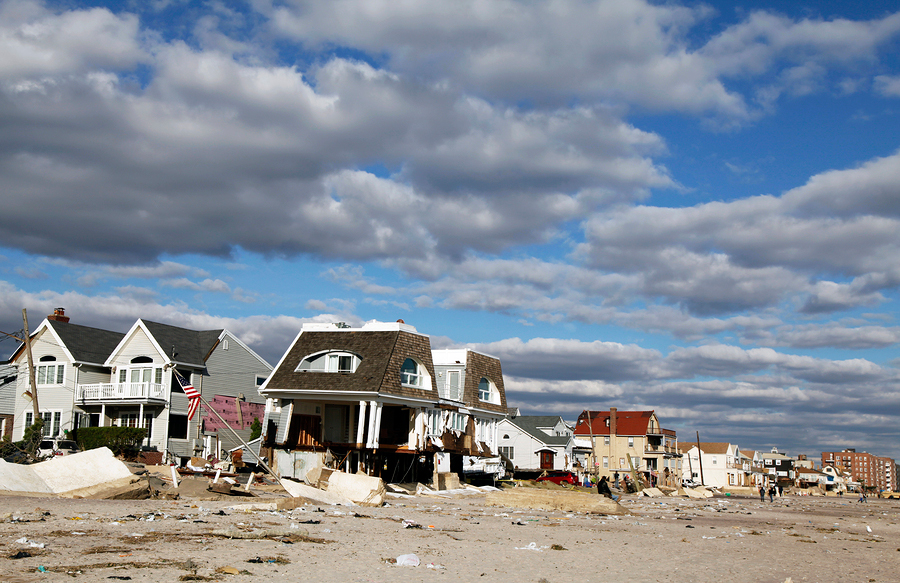
Damages from Hurricane Sandy caused record insurance losses in the US in 2012. (Bigstockphoto.com)
CURWOOD: From the Jennifer and Ted Stanley Studios in Boston, this is Living on Earth. I'm Steve Curwood. Well, it’s official: 2012 was the hottest year ever recorded in the US and the second most severe in terms of extreme weather. It was also one of the most expensive years on record for damage caused by natural disasters, and 90% of the insured property damage around the world occurred right here in the United States.
We turn now to Ernst Rauch, head of the Corporate Climate Center for the re-insurance company Munich Re, to explain why the US was hit so hard by weather damage and why an insurance company needs a climate change expert.
RAUCH: Well, as a matter of fact, Munich Re is analyzing the impacts of climate change on our business, our insurance business, since the 1970s, so it’s more than 30 years. And the main reason is that we are one of the largest risk transfer companies when it comes to natural disasters, and that includes both meteorological disasters like wind storms and flooding, and obviously climate change already has already an impact based on our own data and research on the losses and development of losses of these terrors of the last decade.
CURWOOD: Now, I want to talk to you about a report that your company recently issued that points out that more than 90 percent of all insured property damage in the world occurred in the US last year. Why is that?
RAUCH: Indeed 2012, the national disaster statistics were dominated by weather extremes in the United States. Worldwide, we recorded some 65 billion dollars of insured losses from natural disasters, out of which, almost 60 billion were in the US. And in the US you had two major events: the one was Hurricane Sandy, and at this point in time, the insured losses alone for this event are at some 25 billion dollars.
The second major natural disaster was the drought affecting mainly farming businesses and the agricultural sector, out of which the insurance industry paid some 15 to 17 billion dollars. And that compares with an average payout in the agricultural sector of 9 billion. So, difference in losses between 15 to 17 and 9, that’s mostly attributable to the drought on the farming businesses in 2012.

Agricultural damage from drought and record heat in the Midwest contributed to the high rate of insured losses in 2012. (Bigstockphoto.com)
CURWOOD: So, you’re talking about the insured losses here. How big are the uninsured losses for these disasters?
RAUCH: In 2012, worldwide, the overall economic losses from natural disasters were at about $160 billion US dollars. So, there is a gap between the overall losses between $160 billion dollars out of which $65 billion were paid by the insurance industry. And the difference between these two numbers, that’s either actually either paid by government in terms of subsidies or loans, or they are paid out of private customers who have to carry by themselves the loss burden if they are not insured properly. Of the overall $160 billion dollars in economic losses worldwide from natural disasters in 2012, $110 billion dollars, were in terms of damage in the US alone.
CURWOOD: Why is the United States suffering so much economic loss from natural disasters?
RAUCH: Well, the US has all kinds of natural disasters. That goes from tropical cyclones like Hurricane Sandy to tornadoes… you have flooding events, hailstorm events, all kinds of meteorological events. And other parts of the world, if you think about Europe for instance, we do not have tropical cyclones like Hurricane Sandy - we have very little tornado activity, and that makes some regions, like Europe, less exposed to meteorological disasters compared to the United States.
CURWOOD: Well, these numbers have been going up over the years. Why is that?
RAUCH: Well, if we go back over the last 30 plus years in our database, the number of meteorological disasters worldwide has more than tripled over the last three decades. And, in the same time, in the same period, the number of geophysical events like earthquakes or volcanic eruptions has not really changed. And that’s indeed to us a strong indication that the frequency and severity, both of severe weather events worldwide, has increased over the last decades.
CURWOOD: As we’re speaking, the horrific fires are sweeping across New South Wales and other parts of Australia. The local weather authorities had to add categories of heat warnings for folks… coming up with different color codes for their maps. One, I believe to reach to 56 degrees Celsius, which, for folks here in America, that’s like 133 degrees… what’s going on?
RAUCH: Yeah. What we currently see in Australia is…many places in Australia are new records in terms of high temperatures. This is now for the ongoing season, but if we go back just to 2012, all the United States experienced the warmest year on record. And these are the sorts of developments and records, which concern us as a risk-taker. Of course, this could already have a link to climate change, and will give us a bit of a forecast or insight into what could happen in a warmer world over the next decades and centuries. In a warmer world, we will most likely see more of these events.
CURWOOD: What would you like to see the US government do in terms of addressing climate change and mounting costs associated with it?
RAUCH: I think two tiers of a tragedy have to be addressed. One is the mitigation of future losses and the vulnerability of society, of cities, of people when it comes to natural disasters, and that can be done by improving building codes, land-use planning, and protection measures. And the second tier of a strategy is the reduction of greenhouse gas emissions. And this would only have a positive influence when it comes to our next generation - our children and grandchildren. Greenhouse gasses like CO2 remain for more than 100 years in the atmosphere.
CURWOOD: Ernst Rauch is head of Munich Re’s Corporate Climate Center. Thank you so much for taking the time today!
RAUCH: You’re welcome, it was a pleasure.
CURWOOD: And how much snow do you have there in Munich?
RAUCH: (Laughs). Right now it is only raining. So, we have absolutely no snow here in Munich – it’s green and grey and rainy and warm outside.
Related link:
Munich Re on Natural Disasters in the US
[MUSIC: Captain Beefheart “When I See Mommy, I Feel Like A Mummy” from Shiney Beast (Bat Chain Puller) (Warner Bros 1978).]
Big Buffett Solar Buy
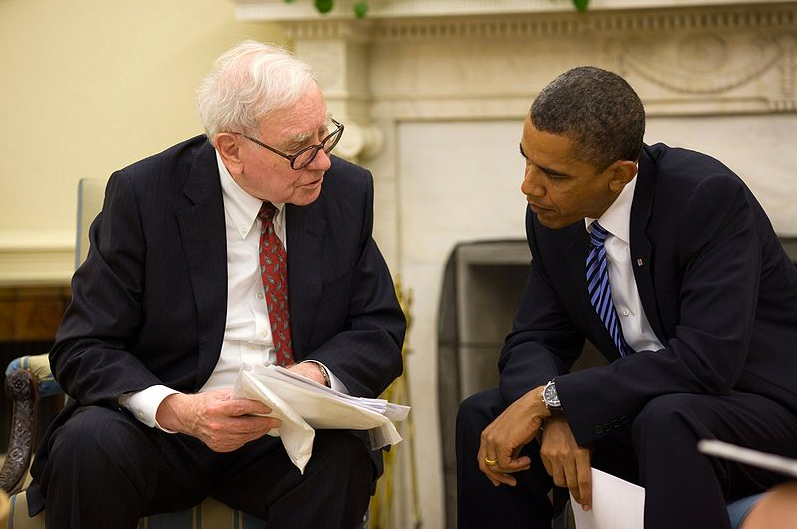
President Barack Obama and Warren Buffett in the Oval Office. (Photo: Pete Souza, Wikipedia)
CURWOOD: Warren Buffett began the New Year with a big buy -- a $2.5 billion investment in two solar projects in Southern California. This isn’t the billionaire’s first venture into renewable energy – Mr. Buffett’s a leader in the sector with multiple wind farms and other solar investments. Ethan Zindler is head of policy analysis at Bloomberg New Energy Finance - welcome to the program!
ZINDLER: Hi! Thanks for having me.
CURWOOD: So, looking at the amount of money that Warren Buffett will make from this investment… first are we talking about him putting his own cash in, or is he borrowing money?
ZINDLER: The projects have been bought by MidAmerican, which is owned by Buffett’s and Brookshire Hathaway. But, what we anticipate at least, is that they will be refinanced, at least, at some future point by the offering of some bonds. He did this previously with projects that he bought with a company called First Solar.
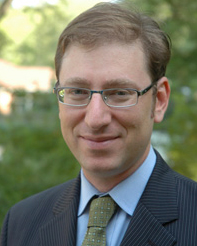
Ethan Zindler, Head of Policy Analysis at Bloomberg New Energy Finance. (Photo: Bloomberg New Energy Finance)
CURWOOD: And, of course, Warren Buffett bonds give him an advantage.
ZINDLER: Yeah, so if you’re Warren Buffett, you can borrow money for usually a pretty good interest rate, you know, that’s part of the strategy here. But in fairness, I don’t think that he’s exploiting, or that MidAmerican is completely expoiting the fact that this is Buffett. What they see, and what I think a number of investors are starting to see is that large scale solar projects that are going to produce a reliable amount of power, and have signed contracts to sell that power at a fairly generous rate, are pretty low-risk investments that can offer a good return. And then they get the extra bonus with the fact that people understand that Warren Buffett does not invest in things unless he thinks that they offer a good opportunity.
CURWOOD: How important was it that he signed on the dotted line just after the so-called fiscal cliff in Washington?
ZINDLER: I don’t think actually that the two are connected. The key tax credit, or subsidy for the solar industry, is what’s called the Investment Tax Credit. And essentially it allows developers to take a 30 percent credit off the cost of their project. So, if you’re building a 100 million dollar project, essentially, 30 million dollars of that cost can be reduced from your future tax bills. And so that’s a pretty generous subsidy, of course, and it’s one that the solar industry actually has on the books for the next several years. It was not one of the things, though, that was on the table in the recently concluded fiscal cliff discussions.
CURWOOD: So, California opened its carbon market at the beginning of this year, how do Warren Buffett’s new solar acquisitions fit into this market, how are they affected by this market?
ZINDLER: To some degree they’re a little bit apples and oranges in the sense that California has on the books its own aggressive, what’s called ‘Renewable Portfolio Standard,’ to install certain amounts of renewable power generation. And that really is a big part of what has been driving large-scale solar activity out there. Certainly, it doesn’t hurt that, if this is going to supplant or replace some generation that might have had emissions, that certainly helps towards California meeting its carbon emissions goals. But the primary driver of renewable energy in California has been the state-level Renewable Portfolio Standard plus the fact that the state is also had some other solar incentives.
CURWOOD: Along with solar, Buffett has also invested in wind and he’s interested in other types of renewable energy. So how likely is it that Warren Buffett will make other acquisitions in the renewable energy sector this year?

Solar panel. (Photo: Bigstock Photos)
ZINDLER: The US market actually is going… we foresee certainly that it’s going to be a bit of a troubled year, for the wind industry this year. And that does get back to an earlier question about the fiscal cliff, and one of the reasons is that that industry relies on a separate tax credit. And that credit technically expired at midnight on December 31, 2012, and then was extended by Congress on January 1, 2013. But the fact that it had been allowed to go as late as it did before being extended, to some degree put the US wind market on hold. While we think that the Buffett deal is a harbinger of things to come, more globally and on a macro basis, there are not necessarily as many large acquisition opportunities out there right now. There are some for wind, but not so many for solar at the moment.
CURWOOD: How much does this acquisition of the solar companies in Southern California mark a turning point for this industry and what does Warren Buffet’s deepening interest in this bode for the foreseeable future, do you think?
ZINDLER: Well, I think it’s a very positive sign. I mean, Warren Buffett deploying two, two and a half billion dollars, that’s capital that’s scale that we don't often see in our industry. This is doing things in a much bigger way and that’s a very positive development for clean energy because if you look at how things like oil pipelines and natural gas pipelines and oil refineries are financed, they’re done in a big way at scale, often with bond offerings or with more sophisticated vehicles than have been available to the clean energy industry, so this is a very positive development in that respect.
And, of course, the other thing is that Buffett is Buffett. You know, he brings the strong reputation with him and a lot of respect throughout the business community. And we’ve heard from clients or even new clients that say that they’ve gotten interested in this area because they want to know what Buffett’s up to.
CURWOOD: Ethan Zindler is head of policy analysis at Bloomberg New Energy Finance. Thanks so much, Ethan!
ZINDLER: Yeah, my pleasure.
Related links:
- MidAmerican Renewables’ solar projects
- The SunPower Corporation
- California’s cap-and-trade program
- More on Ethan Zindler
[MUSIC: Jenny Scheinman “Hard Sole Dance” from Crossing The Field (Koch Records 2008).]
CURWOOD: Just ahead, First Nation activists in Canada are organizing flash mob drum circles and dances - but it's hardly a celebration. Stay tuned to Living on Earth!
[CUTAWAY MUSIC: Max Roach- Clifford Brown: “Joy Spring” from Clifford Brown And Max Roach (Emarcy Records 2000 Reissue).]
Idle No More

Idle No More protesters march in Victoria, British Columbia. (photo: R.A. Patterson)
CURWOOD: It’s Living on Earth, I'm Steve Curwood.
[CHANTING AND DRUMMING SOUNDS]
CURWOOD: Canadian First Nations folk and friends recently drummed and chanted in a flash mob at a shopping mall in Winnipeg to protest Canadian Government policies. They are demonstrating against recent legislation that they say undermines First Nation sovereignty and harms the environment.
They are part of a movement called “Idle No More” that is making a splash in social media as well. Native American environmental activist and one-time Green Party candidate for vice president, Winona LaDuke, recently wrote about Idle No More for the magazine The Progressive. She joins us now from her home on the White Earth Reservation in northern Minnesota not far from the Canadian border. Welcome to Living On Earth!
LADUKE: Thank you, hello!
CURWOOD: So, much like the Occupy Wall Street movement, these protests have rallied around a moniker: “Idle No More.” Where does that phrase come from?
LADUKE: Very Canadian, that’s all I’ve got to say! I think it means: “Get off your butt and let’s get moving”, or “that’s enough!”
CURWOOD: Now, many have traced this back to the passage of a piece of legislation called bill C45 in Canada; can you describe this law for us?
LADUKE: Generally the bill guts every major Canadian environmental law over the past 30 years. Before the passage of bill C45, the 2.6 million lakes, rivers, and Canada’s three ocean shorelines… a lot of water… had some protection. It’s pretty much gone now with the passage of that bill; about 87 of the lakes, rivers, are protected, and those are largely in the ridings of the Conservatives that are part of the Harper government.

Idle No More protesters march in Victoria, British Columbia. (photo: R.A. Patterson)
First Nations are really at the front end of a lot of the assault on the land and the water. The First Nations are a lot of the people who live in the area where the mines are, the tar sands, the destruction that is around Sarnia of 62 chemical plants just inundating these tribal communities. They’re at the front end of it and they’re saying: Not only did you just gut the law, but you didn’t even ask us, and you have some legal obligations under international law, which are called treaties, to talk to us about anything that affects our lands, our territories, and the rights that were reserved and protected under those treaties.
CURWOOD: What are some of the other deeper concerns that are motivating this movement?
LADUKE: Well, the general inequality that exists in Canada. You’re looking at these communities, for example, Theresa Spence, the chief from Attawapiskat First Nation, which is a Cree village up on James Bay, she is from this community that has 4,900 residents, 1/3 of them are under 19, they’ve been through, we’ll go with hell… that’s what I’d describe the colonial policies of Canada. You treat them like third class citizens in their own country, they’re living in camps, they don’t have sanitation. The village next door is importing water because they’ve got E. coli contamination in it. You know, you have basically third world conditions, and then you add to it a diamond mine.
DeBeers, the largest diamond mining corporation in the world, has moved into the north, is bringing billions of dollars worth of diamonds into markets. And when this money is coming into the markets, the pittance is going to these First Nation communities whose sanitation systems have been basically overrun by new workers, by new development, by new exploitation. And so, Theresa Spence comes from a village that has basically been a shame to the Harper government for these past few years because the UN and the Red Cross went in there and said: You know, these people don’t even have housing that is suitable. They’re in minus 40 degrees and the wealth is being extracted by DeBeers. And frankly, that’s kind of a snapshot of Canada. It’s a snapshot of Canada historically, and it’s an accelerated snapshot now.
CURWOOD: So, talk to me about the present protests. What form have they taken?
LADUKE: So, with the use of social media, not unlike Arab Spring, people have been organizing these so-called “flash mobs”- these short protests in very public places. The Mall of America, you know the Mall in Broomfield, at the Capital Rotundas, to be a voice of support for Theresa Spence who is on a hunger strike going into her fourth week now, demanding that Prime Minister Harper meet with Theresa Spence, meet with First Nations and ultimately repeal bill C45. In addition to that and the First Nation guys at Sarnia blockaded a CN Railway. And what they’re blockading is hundreds of train cars full of chemicals moving in and out of their communities. And you know, it’s costing some money to the companies, but hopefully it’s drawing some attention to the fact that this community is really toxic and they have to live there.
CURWOOD: So, Chief Theresa Spence continues on her hunger strike, what role is her hunger strike playing in this movement?
LADUKE: Theresa Spence’s courage has been the catalyst, the flame that lit this. She’s a middle aged Cree woman, you know, Crees are tough, tough people, and she’s courageous enough to go there with her medicines, with her fish broth she’s drinking, and she’s going into her fourth week. The fact that Prime Minister Harper did not have the dignity to meet with the poorest people in the darn country, until now… and he’s saying he’ll meet on the 11th, which is exactly one month after she started her hunger strike right across from his offices… indicates how extremist his government is.
CURWOOD: So, why do you think that “Idle No More” has caught on in America as well? You’re saying that demonstrations are in this country as well as in Canada?
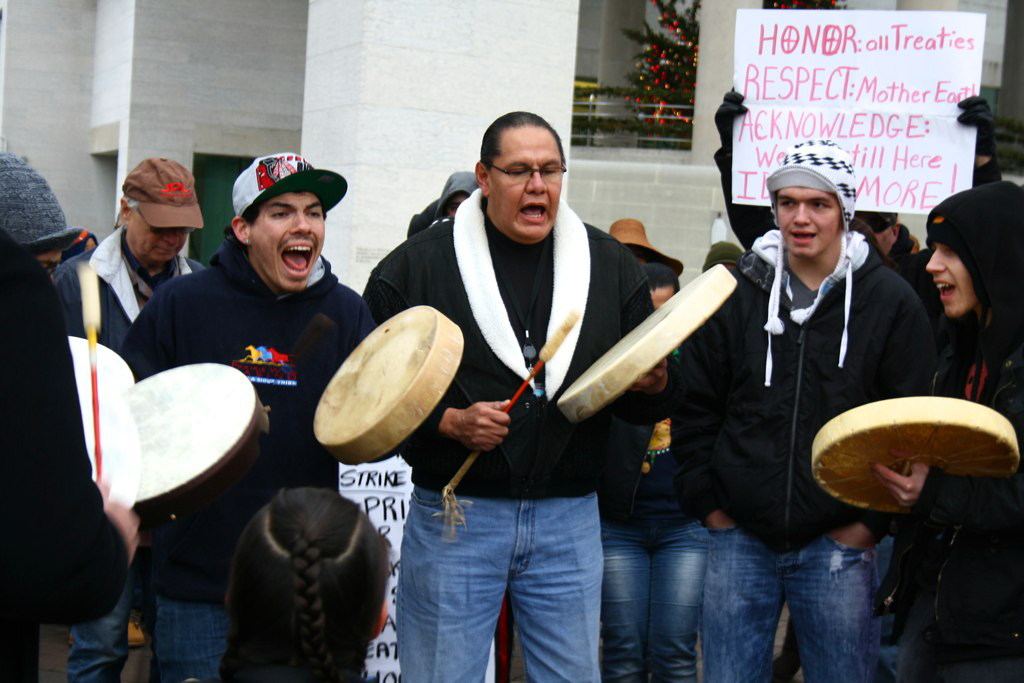
Idle No More protestors drumming at a demonstration in Washington DC. (photo: Jonathan Reed)
LADUKE: Because, I mean, first of all the border is really a colonial creation that is pretty recent. For people like the Anishanabe who are in the northern part of what is called five American states and on the Canadian side what is called four Canadian provinces, predating by 4,500 or 5,000 years or so, our territory. Predates the border. And so rivers don’t have a border, the toxic contamination, the 240 gigatons of carbon that’s going to be in the air out of the tar sands of Alberta, pretty much doesn’t have a border.
And frankly, native people in this country are looking at some pretty dire circumstances too. You’ve got widespread groundwater contamination from uranium mining in the southwestern United States. You have a sacred site, the San Francisco Peaks, being desecrated. You have Rio Tinto Zinc, huge mining corporation about to lay to waste the Upper Peninsula of Michigan where the Keweenaw Band of Ojibwe have been fighting for over a decade, so we have very similar circumstances.
CURWOOD: Where do you think the Idle No More movement is headed?
LADUKE: Well hopefully it’s headed for the repeal of Bill C45. Hopefully it’s headed for some dignity and some negotiations with the First Nations people for some clean… some security for land rights, for water rights, for ecosystems, some reparations for all that wealth which has been pilfered over the past 50 years by major mining corporations with the blessing of the Canadian government. And hopefully it’s going to educate some Canadians and some Americans so that these issues, which are Native issues, but really they aren’t making any new water. You know the water that’s contaminated by chemical companies or by tar sands, is water that is going to contaminate us all. So, hopefully it will get some action that means that people are Idle No More.
CURWOOD: Winona Laduke is a Native American activist, environmentalist and author. Thanks so much Winona!
LADUKE: Thank you for having me!
Related links:
- Idle No More
- Video of Winnipeg Flash Mob Protest on December 26, 2012
[MUSIC: Nels Cline “Prayer Wheel” from Coward (Cryptogramophone Records 2009).]
Introducing the Elf
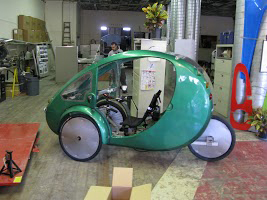
The prototype ELF in the showroom. (Photo: Joanna Rifkin)
CURWOOD: So, among your new year's resolutions - maybe there's one that has to do with getting more exercise - getting out on a bike perhaps. But the dangers of bike riding in the short dark days of winter and the problems of arriving disheveled can put you off. Well, today we report on a new invention that could be an answer for those problems, the Elf.
[SOUNDS FROM VIDEO CLIP: ‘Made in the USA, the Elf is a revolutionary vehicle powered by you and the sun, designed to make your commute more fun, practical, and affordable than ever before. It can legally go anywhere a bike goes, and its three-wheeled stability allows for tight cornering and easy transitions from trail to the street.’]
CURWOOD: That video is from the Kickstarter campaign launched to raise $100,000 to get the Elf off - or rather I should say on the ground. It sounded intriguing enough to send Living on Earth's Helen Palmer on the road.
[TRAFFIC SOUNDS]
PALMER: Organic Transit - that makes of the Elf - occupies an old furniture warehouse in downtown Durham, North Carolina. In the huge showroom window is what looks like a large green egg-shaped motor-cycle side car on top of a racing wheel-chair. Now, a sun-powered tricycle sounds like the brain-child of a young alternative engineer, but its inventor hardly fits that mold.
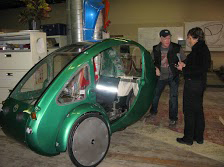
Inventor Rob Cotter shows reporter Helen Palmer the ELF. (Photo: Joanna Rifkin)
COTTER: Hi Helen, I'm Rob Cotter with Organic Transit.
PALMER: Rob Cotter is in his 50s, a slightly rumpled and unassuming-looking engineer with plenty of hands-on experience.
COTTER: Many years ago I was working for Porsche and BMW more on the race-car side of things - and I was living in Southern Calif.- and they were building the Gossamer Condor and Gossamer Albatross - the pedal-powered aircraft - not too far from me, so I kind of linked up with those folks.
PALMER: That led to a host of new possibilities - Cotter's a working inventor who's learned many skills along the way.
COTTER: I became vice president of land for human-powered vehicles, I built a 62mph tricycle about 30 years ago, and from that point on I built lots of funky little vehicles, I learned plastic forming and composites, I put on first solar-powered races in the US - and once I realized you could go highway speeds at one horse power - I realized how inefficient everything is that we do.

Solar Panels on top of the ELF. (Photo: Joanna Rifkin)
PALMER: That realization and all that experience went into making this new alternative vehicle, the Elf – not something from Lord of the Rings – but an acronym.
COTTER: It's actually Electric, Light and Fun.
PALMER: Light and fun - but not tiny.
COTTER: It's under 4 feet wide, 8 feet long and a little under 5 feet tall.
PALMER: At that height, he says, you sit in traffic at eye level with cars. The open sides and huge front windshield mean you can see, and the electric headlights and indicators mean you can be seen; you're protected by a sturdy aluminum frame that anchors the body panels front and back. There's space behind the driver to put a child seat and it can carry up to 350 pounds of cargo, but the Elf is still a bicycle.
COTTER: It has pedals and a chain and drives a rear wheel, but there's also solar panels and an electric motor to help get it down the road.
PALMER: Or up the hill?
COTTER: Yes - or longer distances or carry lots of - you know - cargo.

Steering handles and pedals on the ELF. (Photo: Joanna Rifkin)
PALMER: Rob says the Elf gives people the choice of how much exercise to take - you can use the electric motor to help get up the hills on the way to work - so you don't arrive too sweaty - then let it sit in the sun for the solar panels to charge the battery. And it's not only the Elf's color and its power source that are green.
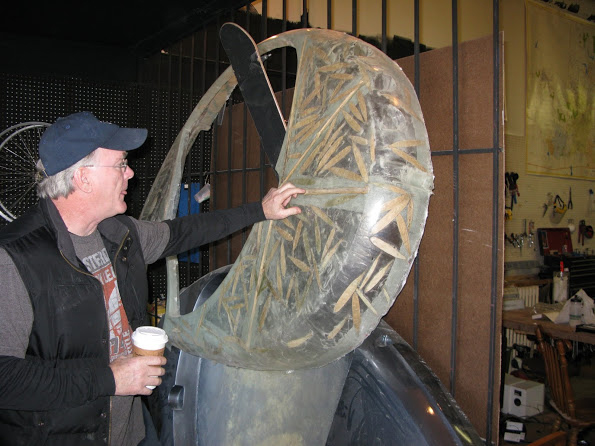
Rob Cotter with ELF side panel; note embedded bamboo leaves. (Photo: Joanna Rifkin)
COTTER: A lot of materials that go into this are recycled materials - as time goes on we're going to use more biological materials - like hemp and seagrass but currently we're using recycled plastic, the aluminum's 45 percent recycled, it's a very efficient package - so efficient that it gets the equivalent of 1800 mpg.
PALMER: But, of course, it uses no gas at all - just human-power, sun-power - and a battery pack with a 30 mile range. It's not built for highways though - only for local roads, and bike trails, as federal regs say a bicycle can't go faster than 20 miles an hour. Cotter says if enough people who drive about 30 miles a day climbed out of their cars and into an Elf - the effect on greenhouse gas emissions could be startling.
COTTER: Each one of these on the road takes about 28 tons of CO2 out of the atmosphere per year.
PALMER: Compared with an equivalent car?
COTTER: That's right, it mitigates the 28 tons - so 100 of these on the road are equivalent to a 4 megawatt wind turbine at about 20% of cost.
PALMER: Ah cost! That's always one of the big questions about any new technology.
COTTER: The base price is $4000 - and basically that's like the wholesale price - but we have over 400 orders or reservations currently, just from our website.
PALMER: And that was before the Kickstarter campaign got underway - they reached their $100,000 funding goal in 12 days and 40 people have actually paid for the vehicles. There's lots of buzz - indeed, one benefit of a store-front is people walk by, see the Elf in the window -- and are intrigued.
[STOREFRONT SOUNDS]
PALMER: I grabbed a couple of window-shoppers…excuse me - what do you make of this?
MORRIS: Well I think it's fascinating - it's kind of intriguing that you can be covered, and fully protected - and still just peddle your way to work or wherever…
PALMER: How about you?
BERM: I think it's exciting - when I was a little kid - I wondered could you make a car from a bicycle - to me this is the sci-fi orgasm of the future is now - and I would love to have one!
PALMER: That's Tim Morris and Steve Berm. Steve's a school-teacher; for now he commutes too far on major highways to make an Elf practical, but he says it could be a perfect set of wheels for his wife. And it's not only casual passers-by who see the Elf and like what they see. Bill Chameides, the Dean of the Nicolas School of the Environment at Duke University envisions the Elf helping green the campus.
CHAMEIDES: Well I think it's such a wonderful wonderful concept. First of all we want people to get out and bike and it’s good for their health and good for the environment, but riding a bicycle's problematic, you're out in the open, you don't have protection from the sun and this wonderful invention, the Elf – you're actually enclosed just like a little tiny car and you've solar power assistance to get up the hills. I think it's a great idea - I would love to set up a thing where for example we had some of our students at the Nicolas School living in downtown Durham and did the trek over to the Duke Campus, which is a few miles and using these little Elfs back and forth, what a great, great idea.
PALMER: Prof. Chameides says students aren't the only ones who could benefit. This kind of invention could give everyone from aging baby-boomers to youngsters greater mobility, as well as helping to fight global warming. Back at Organic Transit's downtown factory, Rob Cotter explains another important feature of the Elf.
COTTER: We're trying to figure out basically how to do a bike factory in a box where we can - you saw how they nest together - and ship and things like that that makes them very transportable and be utilized by assembly points in downtown locations by low-skilled labor.
PALMER: To make that possible, the Elf needs to be as modular as possible, with pre-formed components - the frame, the electronics, and the body - designed to just bolt or clip together. Rob pointed to the pile of panels along the sides of the showroom.
COTTER: This is one of the trilon bodies, so trilon is a composite of acrylic and recycled ABS.
PALMER: What's ABS?
COTTER: A very conventional plastic - so this is a vacuum formed body, so whereas those other ones like that green one there takes us about 2 days - these pop out every 20 minutes.
PALMER: They're making them all locally - along with the wiring for the battery and the electronics, designed by mechanic Biran Highfill.
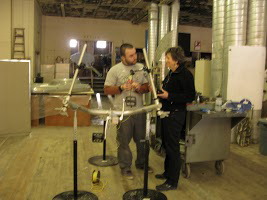
Mechanic Brian Highfill with reporter Helen Palmer. (Photo: Joanna Rifkin)
HIGHFILL: Right now I'm trying to make a bunch of quick disconnects, so if your turn signal switch breaks you just unplug it.
PALMER: What kind of training do you have to have for this?
HIGHFILL: I graduated from Nascar tech Inst – I’ve been a bicycle mechanic for 10 years.
PALMER: So you could do race cars - but you're doing bikes instead?
HIGHFILL: Yeah.
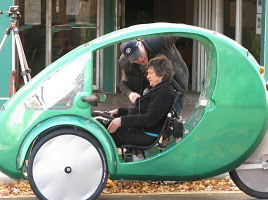
Instruction from Rob Cotter (Photo: Joanna Rifkin)
PALMER: By now I really wanted a personal test-drive in this powered trike – though I was a little apprehensive.
COTTER: We call the green one the green onion.
PALMER: How safe do you think they are if somebody runs into them?
COTTER: Safer than a bicycle! Actually, from years of dealing with human-powered vehicles decades ago we realized that aero-dynamic skin is very safe, so when people crashed at 60 and 70 miles an hour - nothing happened to them – so this is like riding inside a bike helmet. So let me pop this door open here…
PALMER: But with hands full of recorder and microphone - I wasn't sure if I could actually ride or steer the thing - indeed - I couldn't even work out how to climb into it.
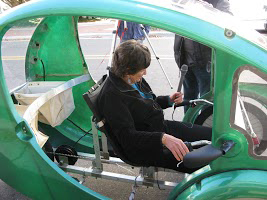
"Where can I put the microphone?"
Helen Palmer prepares to test-drive the ELF.
(Photo: Joanna Rifkin)
COTTER: So what I do - it's kind of like getting into a kayak - so I take a big step - keep your feet on the pedals - it's much the safest to keep your feet on the pedals.
PALMER: So, feet on the pedals - and microphone stuffed inside my jacket - I was ready:
COTTER: So make a left at light - up to the bull - see that bull statue? Make a right after that.
PALMER: And I set off pedaling unsteadily into the traffic..
Wow – I’ve come to red light so I’m stopping - she's letting me go. That’s amazing. I'm turning in front of the traffic. Oh, wow! This is very wonderful. OK it’s quite a bit of actual pedaling so it’s not easy - but I could put on electric motor so let’s try that. Oh, yes I just put the motor on and it’s great! Ok, there’s nothing coming so I can turn round here Oh it’s easy! You get the hang of it in like three minutes. Oh - I'm being followed by a fire engine.
Well - except for the fire-truck, it was fun, but more challenging than I'd expected and given the turn signals and the traffic, there was a lot to remember. But it's certainly easier than learning to ride a bike - and the electric power on the hills was great. It also makes a stir. People stood and watched me weave my way down Durham's Main Street. One of them was Vince Provenzano…
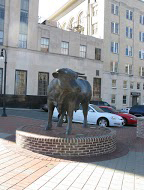
Durham's mascot - the Bull. (Photo: Joanna Rifkin)
PROVENZANO: I thought it was amazing - I'm ecologically–minded, and to see something like that? It's just phenomenal! I was curious as to how much peddling you have to do versus how much energy is stored in battery
PALMER: Well, I have to say, from going round the block, it’s harder to pedal than I'd expected. But, when I came to the hill, I of course put on the battery assist and it shot up the hill! It was great!
PROVENZANO: I think it's phenomenal but it's a great combination mode of transportation: You can exercise, and better yet if you need to go off solar power, just go off solar power. And why not? Takes you outside!
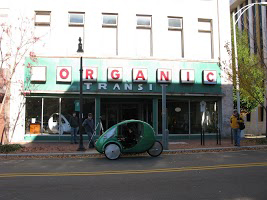
The Elf outside Organic Transit's showroom (Photo: Joanna Rifkin)
PALMER: Over 400 people seem to agree it's a worthwhile enterprise - they supported the Kickstarter campaign and may have helped assure its future. So don't be surprised to see a solar-pedal-powered trike heading down a bike-path near you soon. For Living on Earth, I'm Helen Palmer in Durham, North Carolina.
Related link:
Video from Organic Transit about the ELF
[TRAFFIC SOUNDS]
CURWOOD: There are pictures of the Elf and more at our website, LOE dot ORG.
[MUSIC: Dave Douglas “Dog Star” from Moonshine (Koch Records 2008).]
CURWOOD: Coming up ¬– some good news from the underwater world of coral reefs. Keep listening to Living on Earth!
ANNOUNCER: Funding for Living on Earth comes from the Grantham Foundation for the protection of the environment, supporting strategic communications and collaboration in solving the world’s most pressing environmental problems. The Gordon and Betty Moore Foundation. The Kendeda Fund, furthering the values that contribute to a healthy planet. And Gilman Ordway for coverage of conservation and environmental change.
This is PRI, Public Radio International.
[CUTAWAY MUSIC: M’Boom: “Rumble In The Jungle” from M’Boom (Columbia Records 1979).]
The Kilo is Gaining Weight
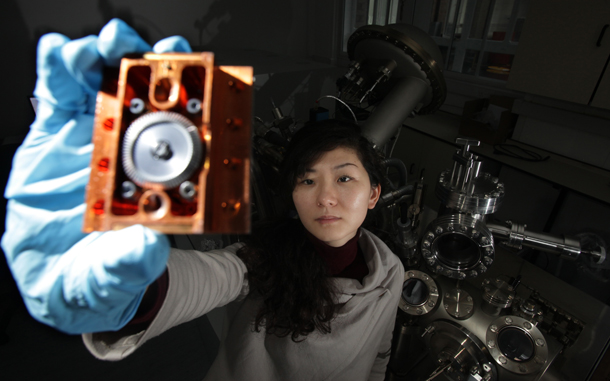
Dr Naoka Sano examining holding a platinum alloy kilogram that has been cleaned by the ozone wash. (photo: Newcastle United)
CURWOOD: It's Living On Earth, I'm Steve Curwood. For those who put on a few pounds - or even a few kilos - over the holiday season, there may be some consolation. It looks like the kilogram itself may be gaining weight. That's right – scientists at Newcastle University in the UK have discovered that the original kilogram standard is ever-so-slightly heavier than it should be. Joining us now to discuss these findings is Dr. Peter Cumpson. He's a professor of Mechanical Engineering at Newcastle University. Welcome To Living On Earth!
CUMPSON: Hello!
CURWOOD: So where did the kilogram put on the weight, around the middle?
CUMPSON: I guess it does, it’s a cylinder so, that’s probably the best place for it. It’s a cylinder of an alloy of platinum and iridium and it was made in the late 19th century, and the surface of it, we think, has been gaining a bit of mass.
CURWOOD: Now, I have to ask you, Peter, we still have a single physical standard for the kilogram?
CUMPSON: That’s right, it’s the only one of the SI units that is still an artifact. It did used to be that the meter was defined by a physical artifact, but no longer. These days, a meter is defined in terms of wavelengths of light. To measure a meter, you have to count something on the order of a billion wavelengths of light. That’s not really a problem, you can count that many wavelengths. But to do the same to count a standard of mass, you would have to count a lot of atoms, orders of magnitude more atoms, 1026 or so, in order to make something about a kilogram. And that’s just really beyond any counting scheme, electronic or otherwise that we’ve got.
The ultimate aim, of course, is to have all of the measurement units realized in terms of atomic properties or fundamental constants like the speed of light, and unfortunately that hasn’t hitherto been possible with the standard of mass.

Dr. Peter Cumpson at work in his laboratory at Newcastle University. (photo: Newcastle University)
CURWOOD: So, we still need a standard kilo.
CUMPSON: We do. And we therefore have to keep a good eye on what’s happening at the surface and whether we’re exposing it to anything which might cause it to grow.
CURWOOD: How can you tell if the kilo has gotten too heavy if the only thing you can measure it against is itself?
CUMPSON: That’s an absolutely crucial point. We don’t really know what’s happening to it, we know what happens to it with respect to other kilogram artifacts made at about the same time. But, in principle, one can only measure the differences between them. What we’ve done is to take samples of platinum iridium alloys and place them in similar environments in similar laboratories, in fact in the same laboratory in some cases, and the result is that you pick up two kinds of contamination. And we think those two kinds must be present on at least a good fraction of the national standard prototypes which are held by all of the developed countries.
One of those types of contamination, as you’d expect, is a kind of carbonaceous contamination or dirt, we might just call it. Which is the same kind of carbon that you get on any surface exposed to air.
CURWOOD: Ahah! Carbohydrates for the kilo!
CUMPSON: Perhaps not very nutritious carbohydrates, but they are carbon based. The other form of contamination is in fact mercury, which is a bit of a surprise. But of course, in these laboratories where these kilograms are kept, often the scientists have to make careful measurements of temperature and pressure. Until recently it has all been done using mercury thermometers or barometers. So, probably over time, it’s quite likely that one or two of these have been broken and led to a certain background of mercury vapor. And mercury forms a nice alloy with platinum so that we’ve certainly found that very rapidly on clean pieces of platinum and platinum iridium alloy, a mercury layer forms.
CURWOOD: What’s the scale of this weight gain of the kilo. How serious a problem is this?
CUMPSON: It’s certainly in the rage of tens of micrograms, and probably of the order of 100 micrograms.
CURWOOD: So, it’s 100 millionths of a kilogram. If we were to imagine that we had 100 million kilos of gold in front of us, we’d be off by a single kilogram.
CUMPSON: That’s right. It’s very tiny. But there are one or two applications where it probably really is important to maintain something like that degree of accuracy. If you have a material where you really need to make sure that you’re receiving just as much material as was dispatched, then a good way of accounting for that is to weigh it before and after it’s sent. So, in particular, things like nuclear materials, very important to weigh them very accurately, so you can make absolutely certain that none of it has gone astray enroute.
CURWOOD: So, what’s been done to get the kilo on a weight loss program?
CUMPSON: Well, probably with the mercury contamination, there’s not a lot to be done now. It probably gained quite a lot of mercury contamination early on, and that’s slowly increasing as the mercury is diffusing into the polishing layer near the surface. The carbonaceous contamination, we’ve been working on a method involving exposure to ultraviolet light and ozone gas, you can apply the same intensity of UV light in the same concentration of ozone, and remove this carbonaceous contamination.
CURWOOD: In other words, sunbathing is what you’re saying.
CUMPSON: It’s a kind of sunbathing. Particularly sunbathing in an environment which is quite rich in ozone. I wouldn’t recommend it for humans, but it’s very good at removing carbonaceous contamination.
CURWOOD: Oh, I see. I was hoping that maybe I could get rid of a few kilos that way.
CUMPSON: Um…I can tell you, you really wouldn’t be happy to try that. It’s quite an aggressive way of removing carbonaceous contamination from surfaces.
CURWOOD: Peter Cumpson is professor of mechanical engineering at Newcastle University in the UK, thank you so much Professor!
CUMPSON: Thank you!
Related link:
Report- Kilo Gains Weight
[MUSIC: Meshell Ndegeocello “Nobody’s Fault But Mine” from Pour une ame souveraine (A tribute to Nina Simone) (Naïve Records 2012).]
A Bright Spot for Coral Reefs
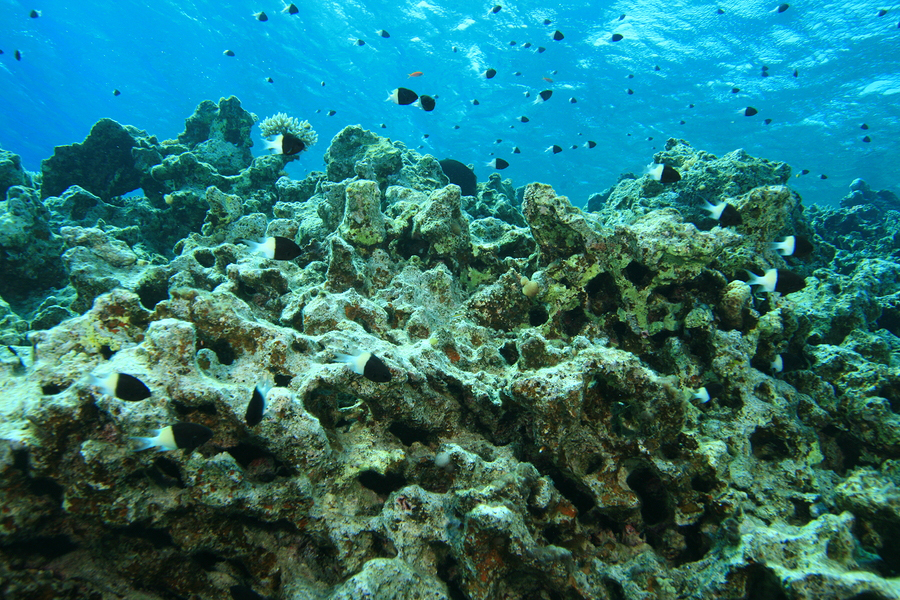
Coral bleeching causes corals to loose all their color and turn a pale white. (Bigstockphoto.com)
CUWROOD: Coral reefs are in dire straits. Late last year the National Oceanic and Atmospheric Administration proposed giving endangered species status to more than 60 different kinds of coral. Oceans around the world are seeing declines in healthy reefs.
Scientists blame overfishing, habitat destruction, changed ocean chemistry and especially hotter temperatures.
But some corals in American Samoa are actually thriving despite the heat. At least that’s what researchers at Stanford University reported recently in the Proceedings of the National Academy of Science. Steve Palumbi is a professor of Marine Science at Stanford University and a lead author on the research. He explained how corals bleach and otherwise react to the stresses of heat.
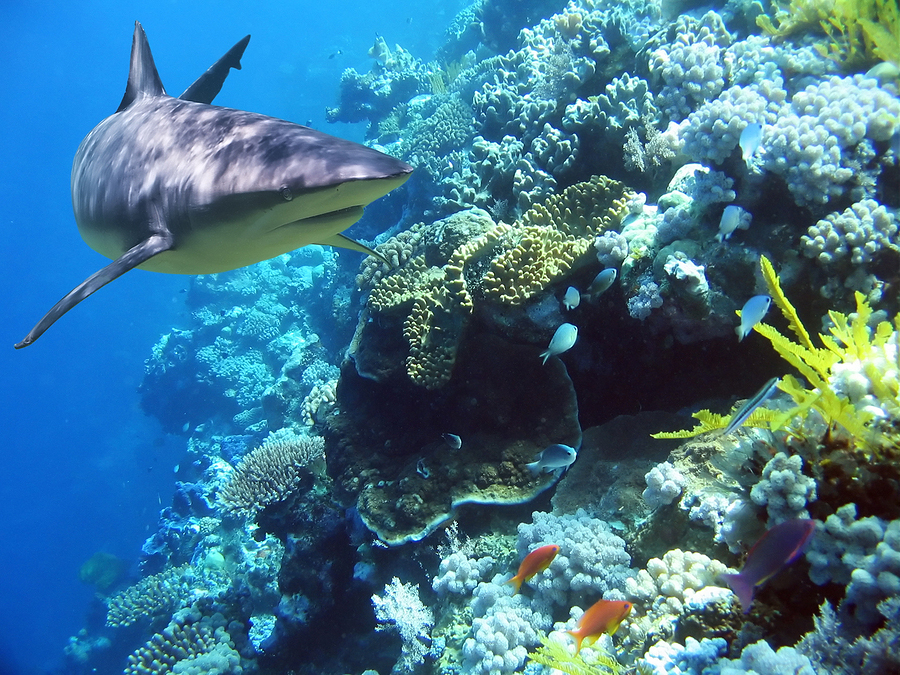
(Bigstockphoto.com)
PALUMBI: Coral bleaching is an event that happens when the water temperature gets a little too high for the coral. It has naturally an internal symbiote, an alga, that it uses to photosynthesize and provide energy. And when that water temperature heats up, that algal interaction with coral breaks down and the coral spits the alga out. And as a consequence, most of them die, 80-90 percent of them die after bleaching. It’s called bleaching because they turn white before they die.
CURWOOD: Where do you see all these coral die-offs?
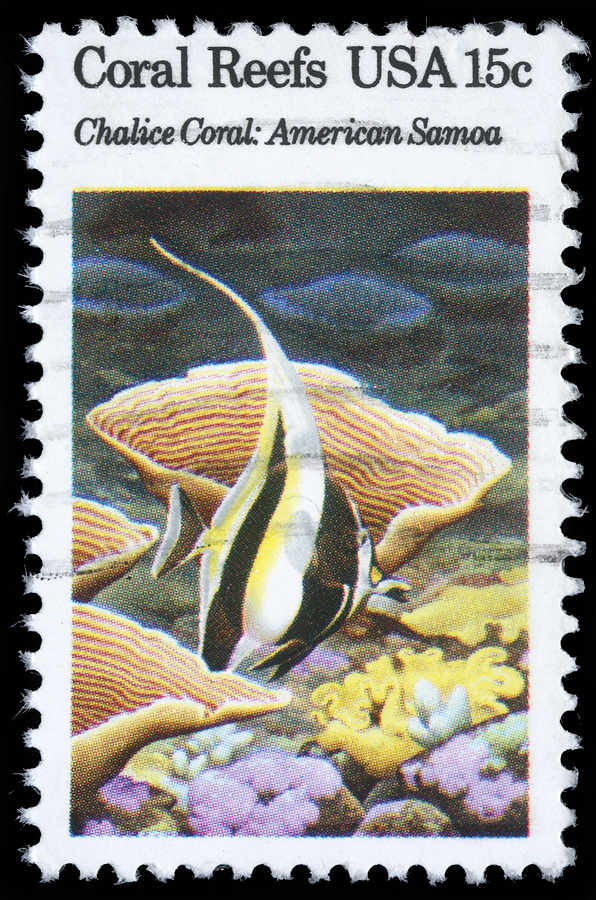
A stamp depicting coral reefs in American Samoa. (Bigstockphoto.com)
PALUMBI: You see them everywhere. The most recent ones, serious bleachings were in Southeast Asia, before that in the Caribbean, throughout the Pacific. There really hasn’t been any single reef in the world, which has been immune to at least one form or other of these problems.
CURWOOD: Your research team, though, found a population of coral that, well, they’re actually thriving, where other corals of the same species around it are struggling. Can you tell me about that please?
PALUMBI: This is in a US National Park - the only US National Park south of the equator– in American Samoa, and back reef lagoons in this park heated up during the summer to 33, 34, 35 degrees Centigrade and in Fahrenheit, that’s about 94, 95 degrees Fahrenheit, almost body temperature, and that’s just way too hot for most corals. They will bleach at much cooler temperatures than that. But the surprise was that in these back reef lagoons, in this very hot water, there were dozens of species of coral thriving and growing and seeming to do quite well. So, we began approaching this area with a simple question: How do these corals manage to live in such warm waters? And what would that tell us about the potential of corals to do better in future warming oceans?
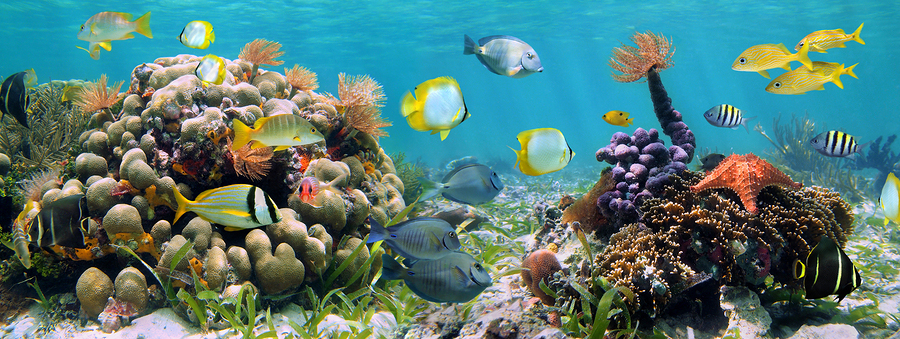
(Bigstockphoto.com)
CURWOOD: Yeah, I mean, that is the question, isn’t it? How do these corals survive when the very same species just down the beach don’t?
PALUMBI: What we think is going on here is that these back reef corals experience heat spikes just about every day. Turns out that low tide in this part of the world is mostly during the middle of the day. And at low tide the back reef lagoons quiet down, the water motion about ceases, the water becomes still and warm, and for those couple of hours of low tide the water stills and spikes, and then it cools off when the tide comes back up. And so we liken it to an exercise regime where a couple hours a day these corals have temperature exercise – they are exposed to high temperature. And our hypothesis is that this periodic heating is like a conditioning regime that conditions them to be able to withstand longer term heat events.
CURWOOD: What about the possibility of simply transplanting some of these heat resistant corals to other parts of the ocean to re-populate areas where their species brethren are dying off?
PALUMBI: So, that’s a possible tool that could be employed in the future if we got really desperate about coral. The way that I think about it, Steve, is that if this is happening and if it’s a broad phenomenon that most corals can do, it buys us a little more time, it buys us a few more decades to solve the global warming problem before corals are around the world way too hot to survive.
CURWOOD: And corals, of course, are so crucial in the marine ecosystem, providing habitat for fish that so many other marine species, and us humans for that matter, rely on. So, if we can’t figure this out, if we can’t help coral adapt or we can’t figure out how this works, what would the ocean look like, say, 50 or 100 years from now?
PALUMBI: If reef corals were dead all over the world, those reefs would look like rubble fields covered in algae, mostly devoid of the kinds of fish that are usually there. Fisheries in places around the world that would rely on them would collapse. There’s about a billion people that rely on coral reefs for fish and fisheries, either for income or for protein. Hundreds of millions of people get most of their animal protein directly from coral reefs.
They also provide an enormous amount of value for surge and storm protection. After Hurricane Sandy, the 60 billion dollars in aid that is flowing into the Northeast is to build storm protection. Well, coral reefs do this for free. They grow storm protection. Corals are going to be going through a pretty tough time in the future, but to be honest it’s the human species that’s going to be having a much harder time.
CURWOOD: So, I’m wondering, how old are corals in terms of biology and evolution and if they’ve been through different temperature regimes on the planet, might they have something to teach us?
PALUMBI: I think that’s an excellent perspective, Steve. Corals as a group have been around for a quarter of a billion years. They’ve seen a lot of change. And our approach to this has always been to say: Let’s look out there in the world at the variation in marine organisms, they have lived in our very diverse ocean for a very long time. Maybe they have some of the tools and some of the skills to react to changing climate that we could use, that we certainly know about. So, part of our mission here is to look for resilience in organisms to climate change, find out where wildlife is winning, and use that knowledge to map resilience, and hopefully use that to protect those areas that are more resilient in the future.
CURWOOD: Steve Palumbi is Professor of marine science at Stanford University, thank you so much, Steve!
PALUMBI: It's a pleasure, Steve. Thank you very much.
Related links:
- Report on Coral Resilience to Climate change
- More about Prof. Stephen Palumbi
[MUSIC: BIRDNOTE® THEME]
BirdNote®
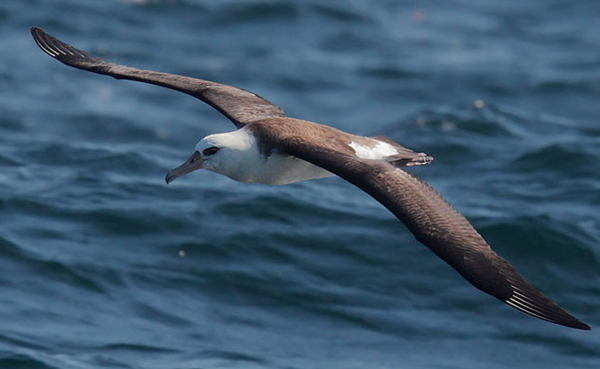
A Layson Albatross in flight. (Photo: © Tom Grey)
CURWOOD: Now American Samoa sounds like an inviting place to go visit at this time of year. And the same might be well said of another Pacific Island several thousand miles to the north. Here's Michael Stein with today's Birdnote®.
[LAYSON ALBATROSS - GROANING, BILL CLACKING, WHINNIES]
STEIN: Welcome to Midway Atoll! More than 1,200 miles northwest of Honolulu – winter home to nearly a million nesting albatrosses. Gathered together, they make a splendid racket.
[LAYSON ALBATROSS MOANS, WHINNIES, BILL CLACKING]
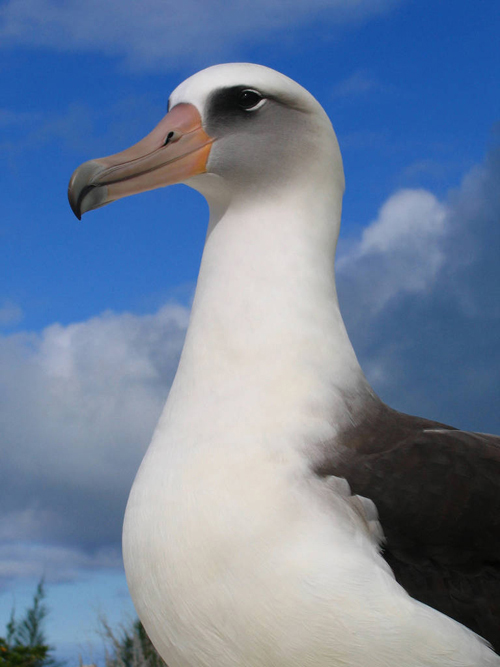
A Layson Albatross (Photo: USFWS David Patte)
STEIN: Most are Layson Albatrosses, huge, handsome seabirds with white bodies and dark, saber-shaped wings six feet across. Laysons return to Midway in November to breed. Roughly 450,000 pairs wedge their way into a scant 2.5 square miles of land surface, creating one of the world’s most spectacular seabird colonies.
[LAYSON ALBATROSS SOUNDS: WHINNIES, BILL CLACKING]
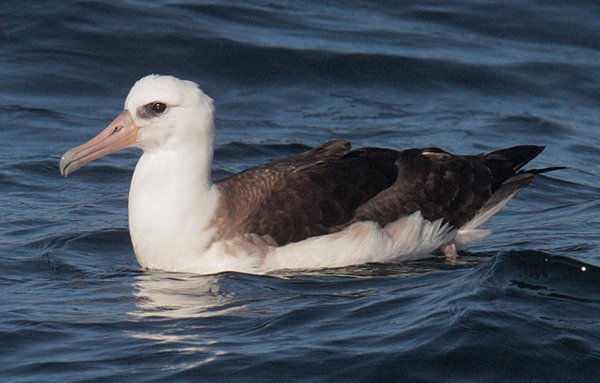
A Layson Albatross afloat. (Photo: © Tom Grey)
STEIN: It may seem curious that Laysons nest in winter, when most birds nest in spring and summer. Well, the big birds forage mostly at night, so the longer hours of darkness in winter provide more time to find food for their rapidly growing chicks.
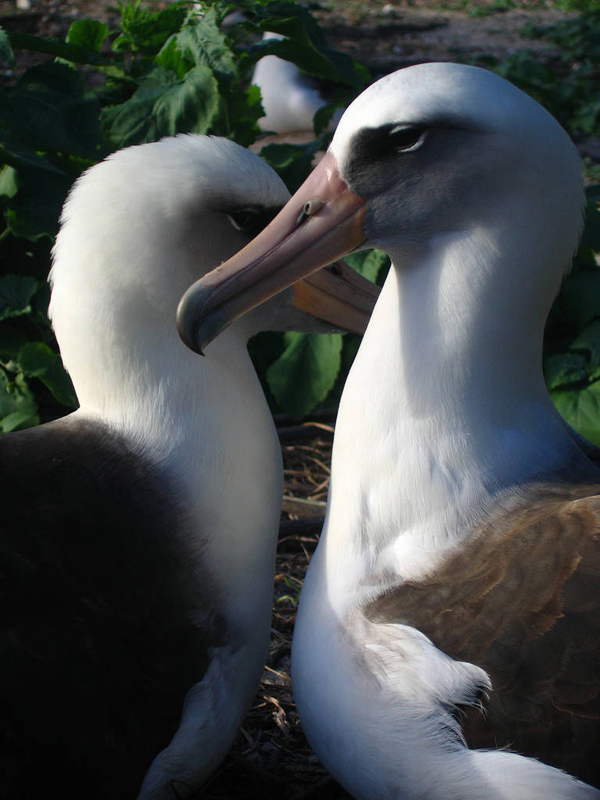
A Layson Albatross pair. (Photo: USFWS David Patte)
Beginning in late January, when the single chick hatches, both parents will feed it for the next six months. And by mid-May, it may weigh seven pounds, even heavier than an average adult. The young bird will need that extra fat and energy, as it learns to fly.
[LAYSON ALBATROSS SOUNDS: MOANS, WHINNIES, BILL CLACKING]
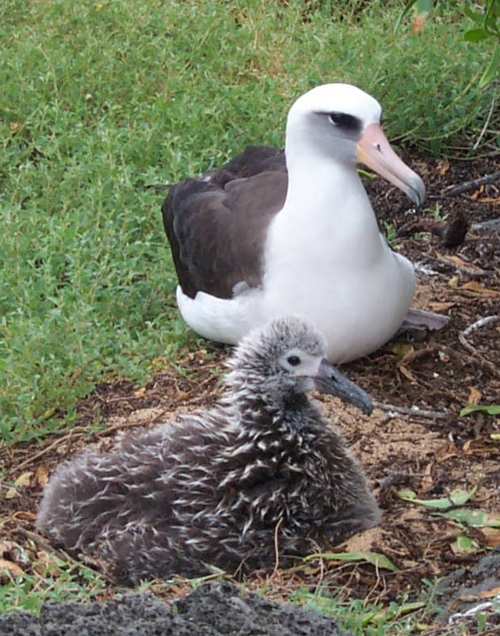
A Layson Albatross with a chick. (Photo: USFWS Chuck Swenson)
STEIN: By August, the once-noisy colony is all but empty, the spectacle complete, as the albatross multitude returns to life on the ocean – until next winter.
I’m Michael Stein.
[Written by Bob Sundstrom
Bird sounds provided by The Macaulay Library of Natural Sounds at the Cornell Lab of Ornithology, Ithaca, New York. Layson Albatross 959-2 (all sounds) recorded by E.Booth
Producer: John Kessler
Executive Producer: Chris Peterson
© 2013 Tune In to Nature.org January 2013 Narrator: Michael Stein]
Related link:
BirdNote ®
[WAVES SOUNDS]
[MUSIC: Fleetwood Mac “Albatross” from The Pious Bird Of Good Omen (Blue Horizon Records 1999 Reissue).]
CURWOOD: There are pictures of these amazing albatrosses at our website - LOE dot org.
CURWOOD: Living on Earth is produced by the World Media Foundation. Bobby Bascomb, Emmett Fitzgerald, Helen Palmer, Annie Sneed, James Curwood, Meghan Miner, and Gabriela Romanow all help to make our show. Jeff Turton is our technical director. Alison Lirish Dean composed our themes. You can find us anytime at L-O-E dot org - and check out our Facebook page - it’s PRI’s Living on Earth. I'm Steve Curwood.
Thanks for listening!
ANNOUNCER: Funding for Living on Earth comes from Stonyfield Farm, makers of organic yogurt, smoothies, and more. Stonyfield invites you to just eat organic for a day. Details at just eat organic dot com. Support also comes from you our listeners. The Go Forward Fund and Pax World Mutual and Exchange Traded Funds, integrating environmental, social and governance factors into investment analysis and decision making. On the web at Pax World dot com. Pax World, for tomorrow.
ANNOUNCER 2: PRI Public Radio International.
Living on Earth wants to hear from you!
Living on Earth
62 Calef Highway, Suite 212
Lee, NH 03861
Telephone: 617-287-4121
E-mail: comments@loe.org
Newsletter [Click here]
Donate to Living on Earth!
Living on Earth is an independent media program and relies entirely on contributions from listeners and institutions supporting public service. Please donate now to preserve an independent environmental voice.
NewsletterLiving on Earth offers a weekly delivery of the show's rundown to your mailbox. Sign up for our newsletter today!
 Sailors For The Sea: Be the change you want to sea.
Sailors For The Sea: Be the change you want to sea.
 The Grantham Foundation for the Protection of the Environment: Committed to protecting and improving the health of the global environment.
The Grantham Foundation for the Protection of the Environment: Committed to protecting and improving the health of the global environment.
 Contribute to Living on Earth and receive, as our gift to you, an archival print of one of Mark Seth Lender's extraordinary wildlife photographs. Follow the link to see Mark's current collection of photographs.
Contribute to Living on Earth and receive, as our gift to you, an archival print of one of Mark Seth Lender's extraordinary wildlife photographs. Follow the link to see Mark's current collection of photographs.
 Buy a signed copy of Mark Seth Lender's book Smeagull the Seagull & support Living on Earth
Buy a signed copy of Mark Seth Lender's book Smeagull the Seagull & support Living on Earth

